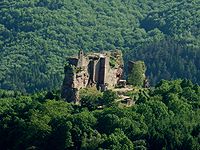
Château du Fleckenstein
Encyclopedia


Castle
A castle is a type of fortified structure built in Europe and the Middle East during the Middle Ages by European nobility. Scholars debate the scope of the word castle, but usually consider it to be the private fortified residence of a lord or noble...
in the commune of Lembach
Lembach
Lembach is a commune in the Bas-Rhin department in Alsace in north-eastern France.-Geography:Lembach lies in the Sauer valley, surrounded by the woods and sandstone cliffs of the North Vosges natural Park...
, in the Bas-Rhin
Bas-Rhin
Bas-Rhin is a department of France. The name means "Lower Rhine". It is the more populous and densely populated of the two departments of the Alsace region, with 1,079,013 inhabitants in 2006.- History :...
département of France
France
The French Republic , The French Republic , The French Republic , (commonly known as France , is a unitary semi-presidential republic in Western Europe with several overseas territories and islands located on other continents and in the Indian, Pacific, and Atlantic oceans. Metropolitan France...
. This fortress, built in the shape of 52 m long boat, has a long history. The castle was built on a sandstone
Sandstone
Sandstone is a sedimentary rock composed mainly of sand-sized minerals or rock grains.Most sandstone is composed of quartz and/or feldspar because these are the most common minerals in the Earth's crust. Like sand, sandstone may be any colour, but the most common colours are tan, brown, yellow,...
summit in the Middle Ages
Middle Ages
The Middle Ages is a periodization of European history from the 5th century to the 15th century. The Middle Ages follows the fall of the Western Roman Empire in 476 and precedes the Early Modern Era. It is the middle period of a three-period division of Western history: Classic, Medieval and Modern...
. An ingenious system for collecting rainwater fed a cistern and a hoist allowed water and other loads to be moved to the upper floors.
History
A castle is known to have existed on the site in 1165. It is named after the Fleckenstein family, owners until the death of the last male heir in 1720 when it passed to the Vitzthum d'Egersberg family. The family had had a lordship that consisted of 4 separate small territories in the Bas-Rhin département. In 1807, it passed to J.-L. Apffel and in 1812 to General Harty, baron of Pierrebourg (the French for Fleckenstein: stone town). In 1919 it became the property of the French state.The rock and the castle have been modified and modernised many times. Of the Romanesque
Romanesque architecture
Romanesque architecture is an architectural style of Medieval Europe characterised by semi-circular arches. There is no consensus for the beginning date of the Romanesque architecture, with proposals ranging from the 6th to the 10th century. It developed in the 12th century into the Gothic style,...
castle, remains include steps cut into the length of the rock, troglodyte rooms and a cistern. The lower part of the well tower dates from the 13th or 14th century, the rest from the 15th and 16th. The inner door in the lower courtyard carries the faded inscription 1407 (or 1423); the outer door 1429 (or 1428). The stairwell tower is decorated with the arms
Coat of arms
A coat of arms is a unique heraldic design on a shield or escutcheon or on a surcoat or tabard used to cover and protect armour and to identify the wearer. Thus the term is often stated as "coat-armour", because it was anciently displayed on the front of a coat of cloth...
of Friedrich von Fleckenstein (died 1559) and those of his second wife, Catherine von Cronberg (married 1537).
The 16th century castle, modernised between 1541 and 1570, was shared between the two branches of the Fleckenstein family. Documents from the 16th century describe the castle and a watercolour copy of a 1562 tapestry
Tapestry
Tapestry is a form of textile art, traditionally woven on a vertical loom, however it can also be woven on a floor loom as well. It is composed of two sets of interlaced threads, those running parallel to the length and those parallel to the width ; the warp threads are set up under tension on a...
shows its appearance in this period. The castle was destroyed in 1689 by General Melac
Ezechiel du Mas, Comte de Melac
Ezéchiel du Mas, Comte de Mélac was a career soldier in the French army under King Louis XIV and war minister Louvois....
. Major restoration work was carried out after 1870, around 1908 and again since 1958.
Château du Fleckenstein has been listed as a monument historique
Monument historique
A monument historique is a National Heritage Site of France. It also refers to a state procedure in France by which national heritage protection is extended to a building or a specific part of a building, a collection of buildings, or gardens, bridges, and other structures, because of their...
by the French Ministry of Culture since 1898.

